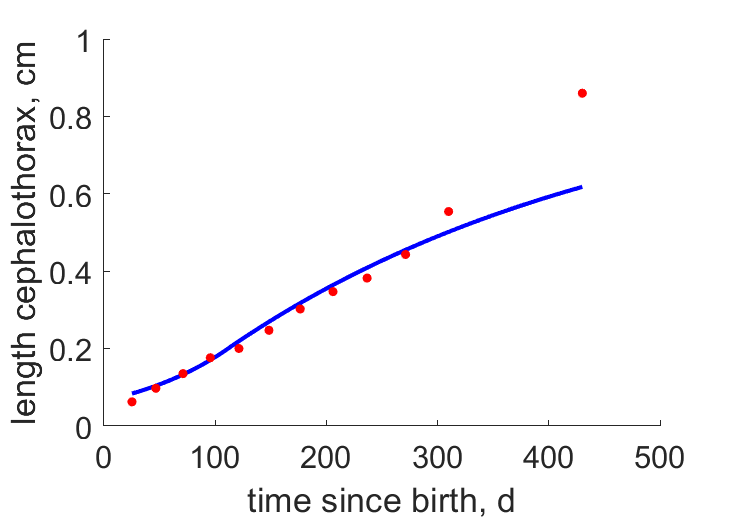Predictions & Data for this entry
| Model: abj | climate: A | migrate: | phylum: |
| COMPLETE = 2.5 | ecozone: TN | food: biCi | class: |
| MRE = 0.030 | habitat: 0jTf, 0jTg, 0iTi | gender: D | order: |
| SMSE = 0.005 | embryo: Tnsf | reprod: O | family: |
Zero-variate data
| Data | Observed | Predicted | (RE) | Unit | Description | Reference |
|---|---|---|---|---|---|---|
| ab | 23 | 22.55 | (0.0195) | d | age at birth | MoreDelC2011 |
| tp | 271 | 278.8 | (0.02866) | d | time since birth at puberty | MoreDelC2011 |
| am | 430 | 429.4 | (0.001489) | d | life span | MoreDelC2011 |
| Lb | 0.062 | 0.06454 | (0.04096) | cm | cephalothorax length at birth | MoreDelC2011 |
| Lp | 0.443 | 0.4644 | (0.04828) | cm | cephalothorax length at puberty | MoreDelC2011 |
| Li | 0.86 | 0.9098 | (0.05791) | cm | ultimate cephalothorax length for female | MoreDelC2011 |
| Lim | 0.7 | 0.7 | (2.835e-05) | cm | ultimate cephalothorax length for male | MoreDelC2011 |
| Wwb | 0.000267 | 0.0002622 | (0.0179) | g | wet weight at birth | MoreDelC2011 |
| Wwp | 0.097 | 0.09768 | (0.00706) | g | wet weight at puberty | MoreDelC2011 |
| Wwi | 0.72 | 0.7346 | (0.02022) | g | ultimate wet weight | MoreDelC2011 |
| Ri | 2.761 | 2.765 | (0.00137) | #/d | maximum reprod rate | MoreDelC2011 |
Uni- and bivariate data
| Data | Figure | Independent variable | Dependent variable | (RE) | Reference |
|---|---|---|---|---|---|
| tL |  | time since birth | length cephalothorax | (0.1164) | MoreDelC2011 |
Pseudo-data at Tref = 20°C
| Data | Generalised animal | Aglaoctenus lagotis | Unit | Description |
|---|---|---|---|---|
| v | 0.02 | 0.006203 | cm/d | energy conductance |
| kap | 0.8 | 0.8573 | - | allocation fraction to soma |
| kap_R | 0.95 | 0.95 | - | reproduction efficiency |
| p_M | 18 | 25.15 | J/d.cm^3 | vol-spec som maint |
| k_J | 0.002 | 0.002 | 1/d | maturity maint rate coefficient |
| kap_G | 0.8 | 0.8019 | - | growth efficiency |
Discussion
- Males are assumed to differ from females by {p_Am} only
Facts
- two clutches during last instar; If eggs sac was removed, a new one was produced with less eggs. First instar stays first 5 d in egg sac (Ref: MoreDelC2011)
- The energy to make the eggs in the first sac comes from food eaten in earlier instars. The period that spiders are adults and the weather is dry with low prey availability (June to September). In the development phase the climate is more humid with greater prey availability (October to May). (Ref: More2014)
Bibliography